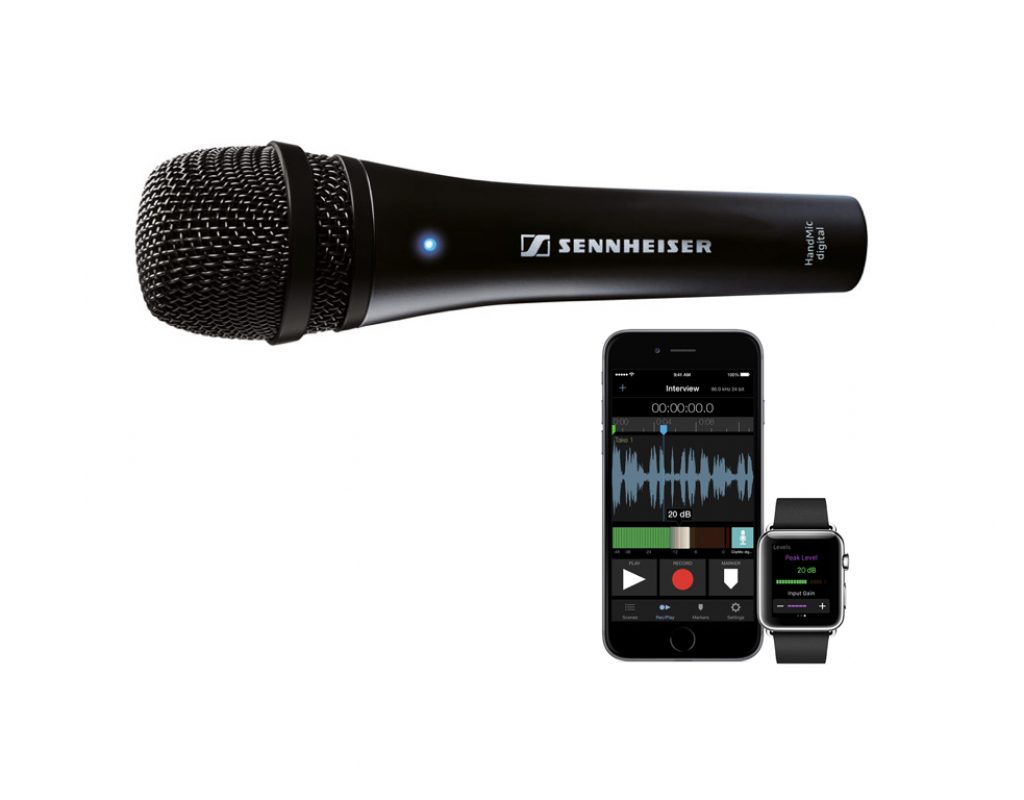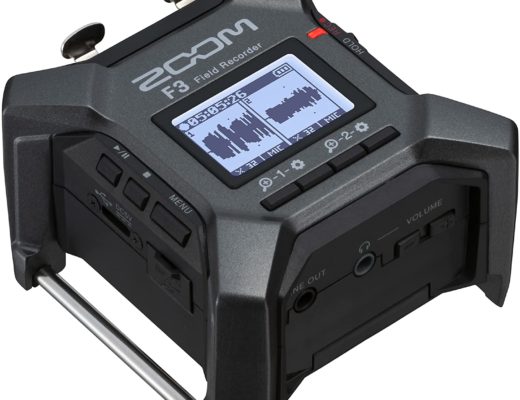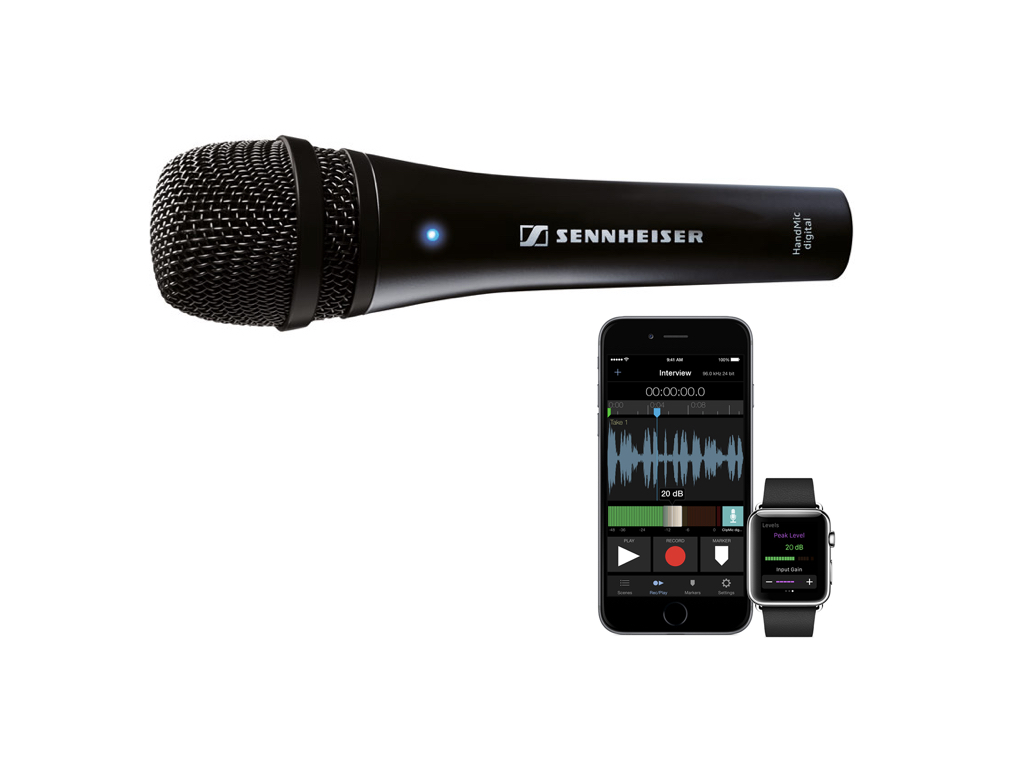
The HandMic Digital from Sennheiser is the only dynamic mic I’ve encountered that ships with a Lightning cable, since the others I have used and reviewed have been electret condenser. It’s also the only microphone I’ve ever reviewed with a switchable built-in hardware limiter, although I have tested audio interfaces and mixers which include this extremely powerful, high-end function. Strangely, Sennheiser doesn’t promote this compelling feature, so I had to perform reverse engineering to prove its existence and nature, via its behavior. The HandMic Digital has other tricks in its built-in DSP (digital signal processor) and is targeted mainly for use with iOS devices like iPhone/iPad iPod Touch, although it can also work with macOS. The HandMic Digital represents a Sennheiser partnership with Apogee, the company that builds the microphone’s built-in preamplifier and A-to-D (analog-to-digital) converter. Together with the matching MetaRecorder app from Apogee, the HandMic Digital is the first microphone I’ve ever used that allows remote control recording from an Apple Watch. Let’s explore, listen to a test recording I made, and make some tough conclusions.
In this article
- HandMic Digital published specs
- Advantages and disadvantages of dynamic mic technology (as opposed to electret condenser)
- Advantages and disadvantages of the cardioid pattern (as opposed to the omnidirectional pattern)
- Software to adjust internal DSP/hardware limiter and more
- Control the MetaRecorder from an Apple Watch
- Internal LED for partial confidence/avoid mic flag
- The HandMic Digital has no inboard monitoring capability (i.e. headphone jack)
- What comes included with the HandMic Digital
- Conclusions
HandMic Digital published specs
Dimensions: ø 48 mm, 180 mm length
Connector: Apple MFi certified Lightning connector or USB
Frequency response (Microphone): 40 – 16,000Hz
Max. sound pressure level: @ min. gain: 134 dB @ max. gain: 99 dB
Cable length: approx. 2 meters (6.6’)
Transducer principle: Dynamic
Weight: approx. 340 g
Pick-up pattern: Cardioid
AD conversion: Apogee PureDigital A/D conversion
Power: supplied by iOS device or USB
Sensitivity: @ min. gain: –54 dBFS @ max. gain: –19 dBFS
Operating relative humidity: max. 95% @40%
Latency: OS and app dependent (typ. < 0.5 ms)
Noise Level: @ min. gain: –96 dBFS(A) @ max. gain: –74 dBFS(A)
Temperature Range: 0 °C to +50 °C
Storage: –25 °C to +70 °C
Word Length16 / 24 bit
Internal signal processing: selectable presets via Apogee‘s Maestro App
Type of códec: multibit DeltaSigma
Sampling frequencies available: 44.1 / 48 / 88.2 / 96 kHz
Advantages and disadvantages of dynamic mic technology (as opposed to electret condenser)
Although there can be exceptions to the rule, generally speaking, dynamic microphones are considered to be more robust and handle drops better than most electret condenser microphones. Also, general speaking, most dynamic microphones obey the inverse-square law faster than most electret condenser microphones, meaning that dynamic mics are less sensitive to sounds that are further away. This means that they are less sensitive to background sounds or room reverberation, although there is not a huge difference, and I have recently reviewed two electret condenser microphones that behave more like a dynamic mic in this respect. These are some of the reasons why many news organizations have preferred dynamic technology when choosing handheld microphones for informal interviews in the field (not for shotguns, or lavalier mics in most cases). Those are also some of the reasons why some producers prefer dynamic microphones for use in home studios that are not acoustically treated.
On the other hand, some people prefer electret condenser microphones since they generally have a wider frequency response and a hotter output, while dynamic mics often require a stronger preamp (or pre-preamp like a Fethead). This last point is not an issue with the HandMic Digital reviewed in this article, since it contains an inboard matching internal preamp. Here is my test recording:
Audio PlayerThe sound is great for voice recordings in my opinion.
Advantages and disadvantages of the cardioid pattern (as opposed to the omnidirectional pattern)
The HandMic Digital has a cardioid pattern. The advantage of the cardioid (somewhat directional, heart-shaped) pattern is that it isolates the source sound more. This means that less background sound is picked up, and (in the case of multiple microphones) there will be less spill or crosstalk, where the voice of one individual leaks into the microphone of another. Spill/crosstalk is not an issue with single microphones.
On the other hand, for informal, single microphone interviews in the field, many broadcast news organizations have long preferred using omnidirectional mics due to their forgiveness of inevitable unexpected interruptions, where directional mics often cause one of the participants to become either “off mic” (distant) or even inaudible when one of those interruptions occur.
Software dependance to adjust internal DSP/hardware limiter and more
Unlike other digital handheld microphones I have reviewed recently, which have inboard physical gain controls and LED level indications, the HandMic Digital uses software to control its inboard DSP (digital signal processor) to set the output level. These include:
- Apogee Maestro app
- Apogee MetaRecorder app for iOS
- Any recording app that supports Core Audio input control.
Core Audio is a low-level API for dealing with sound in Apple’s iOS and macOS operating systems.
Of those mentioned above, the MetaRecorder app allows both controlling the audio level in the HandMic Digital’s inboard DSP, and recording. That is the app I used to make the test recording you heard above. I was glad to see that the MetaRecorder’s default setting is 48 kHz sampling (see my All audio production & distribution should go 48 kHz. Learn why.) at 24-bit resolution (see my Understanding 24-bit vs 16-bit audio production & distribution).
For advanced recording adjustments —like rumble reducer (their way of calling a low cut/high pass filter), overload eliminator (their way of calling a hardware limiter) and available firmware updates— but no recording itself, Sennheiser and Apogee recommend using Apogee’s Maestro app.
I actually had to perform reverse engineering to determine that these features are indeed in hardware, since so far I haven’t received any answers to my five related questions from Sennheiser’s US media relations department (although they are indeed trying to get the information). I suspect that Sennheiser has to find out the information from Apogee, which probably explains the delay. Here are the steps I followed to determine that these features are indeed in hardware:
- Turn up the gain to the maximum using Apogee’s Maestro app for iOS.
- Force quit the Maestro app.
- Make a recording in the Auphonic app for iOS, while screaming. This is to confirm that I was indeed clipping. It indeed was clipping.
- Force quit the Auphonic app.
- Re-launch the Maestro app and activate the limiter, which Apogee calls “Overload Eliminator”.
- Force quit the Maestro app.
- Reopen the Auphonic app and make a recording while screaming. There was no longer any clipping. The limiter was doing its job perfectly
- Force quit the Auphonic app.
- Completely power down the iPod Touch.
- Disconnect the Lightning cable.
- Wait 33 seconds.
- Reconnect the Lightning cable.
- Power up the iPod Touch.
- Launch the Auphonic app and make a recording while screaming. The limiter continued to work, even without using the Maestro app. This proves that the limiter is indeed in hardware, and that the hardware remembers the setting to have the limiter active, even after powering down the HandMic Digital.
I find it ironically sad that Sennheiser has such a compelling feature in the HandMic Digital to help justify the current price of US$259 (Amazon • B&H) but does not promote it (so far). At least you and I know now! As stated in the introduction of this article, I have seen hardware limiters in audio mixers (Shure and Sound Devices) and a single (now discontinued) interface from Tascam, but never built-into a microphone in this price range. The only other microphone I have ever seen with a built-in hardware limiter is the LEA DSP Engine in the Yellowtec iXm Pro, which starts at US$761. The Yellowtec iXm Pro microphone costs nearly three times that of the HandMic Digital, although to be fair, the Yellowtech iXM Pro has a built-in audio recorder too, and I hope to review it very soon. Both Sennheiser and Yellowtec are German manufacturers, while Apogee is a US company.
If you want to use the Auphonic iOS app to record from the HandMic Digital, you should first set your gain using the Maestro app, since at publication time of this article, the Auphonic iOS app does not have Core Audio input control. I have discussed this with Auphonic, and the company may add Core Audio input control to the Auphonic iOS app in a future update. If and when that happens, you will no longer be required to open up the Maestro app just to set levels, although you will have to use the Maestro app to activate other functions, like the low cut/high pass filter (“rumble reducer”), hardware limiter (“overload eliminator”) and for future firmware updates to the mic. The same applies to recording from the HandMic Digital with any other iOS recording app (audio or video) which does not (yet) have Core Audio input control.
Control the MetaRecorder from an Apple Watch
If you own an Apple Watch, you can control the Apogee MetaRecorder from there.
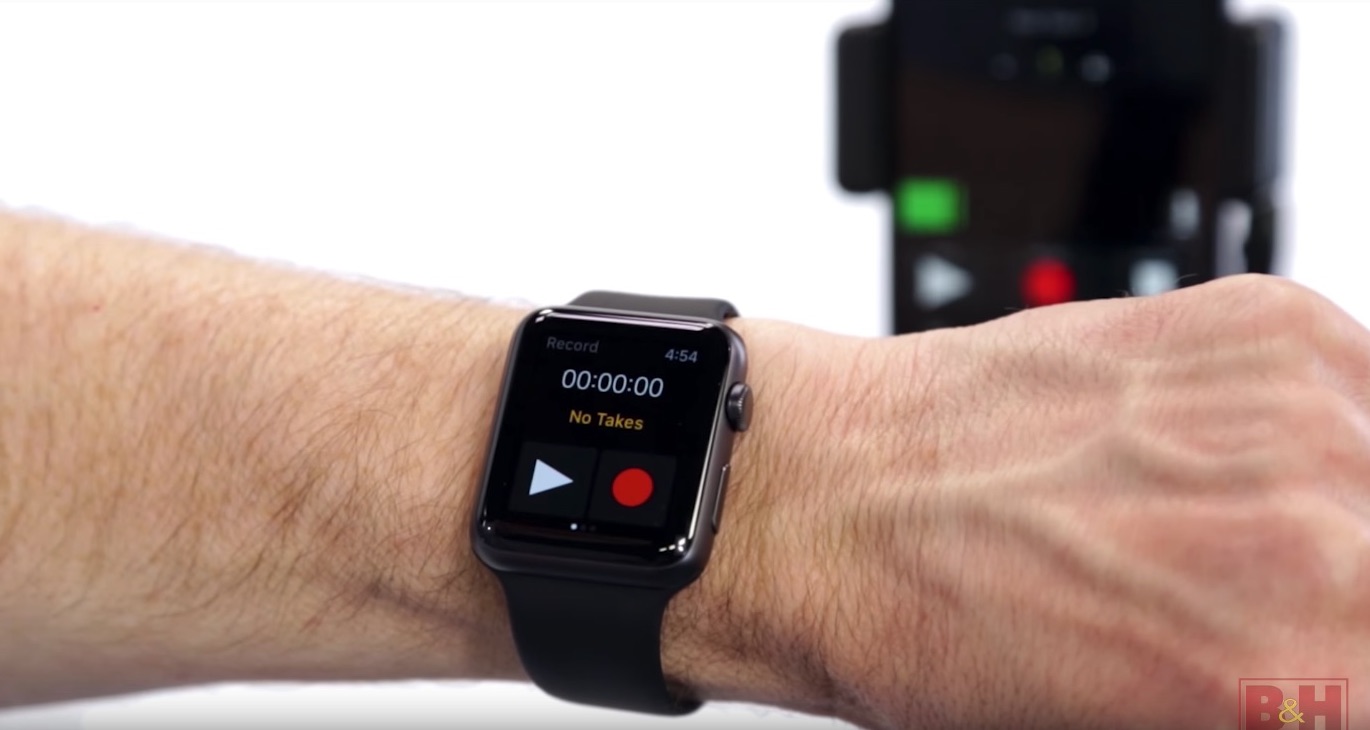
I haven’t found anyone who owns an Apple watch, so I took the above screenshot from a B&H video where Rob demonstrated the MetaRecorder with a different Sennheiser microphone (lavalier), the <US$130 Clip-Mic Digital (B&H). The MetaRecorder app behaves the same with either microphone.
The functions controllable from the Apple Watch include:
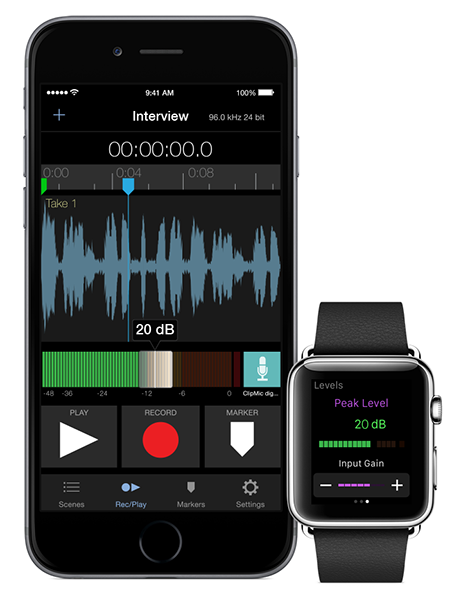
- Set the microphone input level (shown above, photo courtesy of Apogee’s website)
- Add a take to Favorites
- Add Markers
- Start and stop recording (modeled by Rob from B&H in the screenshot at the top of this section)
Internal LED for partial confidence/avoid mic flag

The HandMic Digital has a built-in LED for partial confidence. Unlike other devices I have reviewed, in the case of the HandMic Digital, the LED is not to see the level/gain, but to simultaneously confirm the physical connection and the proper selection of this microphone in a recording app in iOS, as apposed to an internal microphone selection in an iOS app.
This LED in the HandMic Digital is very valuable for that confidence, and therefore, I do not recommend using the HandMic Digital with a mic flag, to avoid blocking visibility of the LED (and also because of the vertical height).
However, using the HandMic Digital with a branded windscreen is ideal for many reasons, as I covered in Branded windscreen vs mic flag: let’s compare, illustrated above.
The HandMic Digital has no inboard monitoring capability (i.e. headphone jack).
Lack of inboard monitoring is increasingly important for several different reasons:
- If you want to hear yourself during a recording with the HandMic Digital for confidence reasons, you will have to monitor yourself via the connected device, assuming it offers an analog headset jack. Hearing yourself live via the connected device always represents some amount of delay (latency), which can be distracting and fatiguing. The amount of delay depends upon the speed of the processor in the connected device and the software used.
- You will still need monitoring if you are going to be a co-host, guest or panelist via Allo, FaceTime, GoToWebinar, Hangouts, Skype, WebinarJam or Zoom in order to hear the other person/people on the other end.
- Starting with the iPhone 7 and iPhone 7 Plus, Apple eliminated the analog TRRS headset jack. This includes the iPhone 8, iPhone 8 Plus and iPhone X. (The current iPod Touch, iPhone SE, iPhone 6s and iPhone 6s Plus still offer an analog TRRS headset jack, as do all current iPads to my knowledge.)
- If you don’t care about hearing yourself during a recording and don’t plan to be a co-host, guest or panelist, you will still need monitoring to check a recording you already made. This means that if your iOS device doesn’t have an analog TRRS headset jack, you will have to disconnect the Lightning cable to hear the playback via the internal speaker or other device you connect via Lightning.
What comes included with the HandMic Digital
- Micro USB to Lightning cable, 2 meters (6.6’)
- Micro USB to USB cable, 2 meters (6.6′)
- Mic clip
- Table stand
- Pouch
- Limited 2-Year warranty
Conclusions
With its inboard hardware limiter and high-quality audio, HandMic Digital (Amazon — B&H) from Sennheiser/Apogee has intriguing features for its US$259 price, especially for iOS users who also own an Apple Watch, don’t desire any monitoring or have one of the waining iOS devices that still offer analog monitoring. However the HandMic Digital is much more limiting than the <US$130 iRig Mic HD 2 from IK Multimedia (reviewed here, Amazon — B&H) or even compared with the <US$100 Sennheiser E835 microphone (Amazon — B&H ) on which the HandMic Digital is based. In fact, anyone who loves the common features of these two mentioned Sennheiser microphones could consider combining the <US$100 Sennheiser E835 with the iRig Pre HD interface from IK Multimedia (reviewed here, Amazon — B&H) and then pay much less while gaining the following advantages:
- Inboard latency-free monitoring
- Compatibility with Android, in addition to Chromebook, iOS (iPhone, iPad, iPod Touch), Mac and Windows
The only loss with that Sennheiser/IK Multimedia combo would be the lack of hardware limiter and low-cut/high-pass filter. There are advantages and disadvantages to each combination.
I have no inside information, but I imagine and hope that Sennheiser is already working on an upgraded model of the HandMic Digital, with inboard latency-free monitoring. I also hope that Apogee will create an Android version of its Maestro app, which would make the HandMic Digital have a larger potential market with Android users.
Be sure to read my related article: How to pick a handheld digital mic for a smartphone/tablet.
Upcoming articles, reviews, radio shows, books and seminars/webinars
Stand by for upcoming articles, reviews, and books. Sign up to my free mailing list by clicking here. Most of my current books are at books.AllanTepper.com, and my personal website is AllanTepper.com.
Si deseas suscribirte a mi lista en castellano, visita aquí. Si prefieres, puedes suscribirte a ambas listas (castellano e inglés).
Listen to his CapicúaFM show at CapicúaFM.com or subscribe via Apple Podcasts, Radio Public or Stitcher.
Save US$20 on Project Fi, Google’s mobile telephony and data
Click here to save US$20 on Project Fi, Google’s mobile telephone and data service which I have covered in these articles.
Learn to speak Castilian, the most widely used Spanish language
FTC disclosure
No manufacturer is specifically paying Allan Tépper or TecnoTur LLC to write this article or the mentioned books. Some of the other manufacturers listed above have contracted Tépper and/or TecnoTur LLC to carry out consulting and/or translations/localizations/transcreations. Many of the manufacturers listed above have sent Allan Tépper review units. Sennheiser lent Allan Tépper the HandMic Digital microphone, and Allan Tépper has agreed to return it as soon has he receives the airway bill. So far, none of the manufacturers listed above is/are sponsors of the TecnoTur programs, although they are welcome to do so, and some are, may be (or may have been) sponsors of ProVideo Coalition magazine. Some links to third parties listed in this article and/or on this web page may indirectly benefit TecnoTur LLC via affiliate programs. Allan Tépper’s opinions are his own.
Copyright and use of this article
The articles contained in the TecnoTur channel in ProVideo Coalition magazine are copyright Allan Tépper/TecnoTur LLC, except where otherwise attributed. Unauthorized use is prohibited without prior approval, except for short quotes which link back to this page, which are encouraged!

Filmtools
Filmmakers go-to destination for pre-production, production & post production equipment!
Shop Now